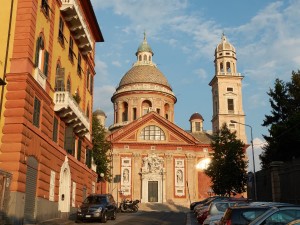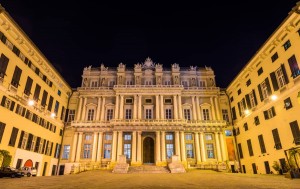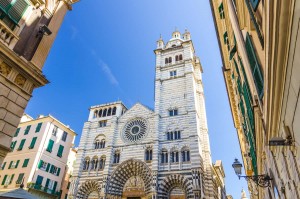Genoa used to be a naval trade power and the “gateway to the vast world”, an imposing republic and a colonial power. Christopher Columbus and Niccolò Paganini were born here, the city’s university is around 550 years old looking back on an illustrious history. However, we rarely talk about Genoa as a city of arts, about the fascinating palaces and magnificent structures along the ostentatious UNESCO World Heritage roads Le Strade Nuove, about the countless churches and art galleries. Time to change that – join us on a tour of Genoa, the city of arts on the coast of the Ligurian Sea!
The legendary Republic of Genoa

©Bigstock.com/Alvaro German Vilela
Come on now, you didn’t seriously think we’d ignore Genoa’s rich history, eh? It. Is. Genoa. Well then, let’s get this show on the road. The name likely derives from “genu”, the Latin word for “knee”, somewhat based on the shape of the coastline. Experts believe that the natural harbour was already used as just that in pre-Christian times. Finds hint at Greek settlements during the 4th century BC. The Romans started to turn the city into their headquarters for battling the Ligurians in 216 BC. Reports of classical writers, however, are rare, and we thus know little about the ancient city. In stark contrast, the ever-changing rulers after the fall of the Western Roman Empire sound familiar. Distinct seaworthiness helped the Genovese along to quickly achieve a civic constitution, to see the fast rise of its navy, and to turn into a medieval colonial power.
Inner conflicts slowed down Genoa’s rise to naval trade power – a role that was gladly taken on eventually. The republic turned into a trade hub, several colonies were established. Trading in oil, wine, leather, soap, grain, silk, but also in slaves flourished. Andrea Doria’s reformation of the republic tried to battle growing Spanish and French influence, but even more domestic discord resulted in the gradual loss of the colonies. Napoleon occupied Genoa in 1796 and founded the Ligurian Republic which, in turn, was eventually annexed by France. However, the republican spirit would not die, and the region later became part of Italy. Remaining an important seaport, Genoa played a decisive role in the Italian economic miracle after World War II. It remains an important worldwide player in trade thanks to its hinterland with Milan, Turin, and connections to Switzerland.
Genoa’s palaces and the World Heritage Site

©Bigstock.com/Leonid Andronov
Right then, let’s finally crack on with the city of arts itself. We don’t want to spend too much time with Le Strade Nuove and the Palazzi dei Rolli as we’ve already taken a fairly close and comprehensive look at these 163 palaces – predominantly built in the 16th and 17th century by rich patrician families during the peak of Genovese trade power – as part of our article on the eponymous UNESCO World Heritage Site. Only 42 of the 163 palaces gained World Heritage status… and there are even more palaces in Genoa.
One you must not miss is Palazzo Reale. Sure, we already talked about it in our very UNESCO piece, but the palace is simply too beautiful and too important to be somewhat ignored. Built for members of the patrician family Balbi between 1618 and 1620, the palazzo was extended, reconfigured and amended over the course of the following decades. The building is mostly known for its monumental façade and the almost magical garden. Palazzo Reale currently is home to an art gallery with over 200 paintings by Genovese and other Italian and international masters. It also features impressive frescoes and rather masterful furniture made between the 17th and the 20th century.
Genoa’s churches and cemeteries

©Bigstock.com/Aliaksandr Antanovich
There’s even more to the city of arts than the impressive palaces of pomp and grandeur. You will find countless religious buildings and monumental cemeteries throughout Genoa. We have picked some of our favourites for you:
- San Lorenzo Cathedral: Genoa’s cathedral proudly displays its extensive building history from 1100 until the end of the 15th Romanesque and Gothic elements alternate and accentuate one another. The interior with its monumental paintings and equally imposing sculptures is particularly splendid.
- Santa Maria Assunta: It goes without saying that there’s a hint of Renaissance architecture in the heart of the city. Basilica di Santa Maria Assunta is situated on the Carignano hill right in the city centre. Construction of the central-plan building began in 1549 and took five decades. The basilica managed to retain its original charm despite extensive 19th century remodelling.
- Synagogue: Unlike other Genovese churches the synagogue is fairly young. The eclecticism-style building made of reinforced concrete with rock cladding was constructed in 1934-35. The upper floor houses a Jewish museum.
- Santo Stefano: Situated on a lift, this church overlooks the main road Via XX Settembre. Legend has it that Columbus was baptised in Santo Stefano. This prime example of Ligurian Romanesque architecture was compacted over the course of several centuries – some chapels were demolished for lack of space – yet the church really shines ever since its de facto new construction after World War II.
- Monumental Cemetery of Staglieno: The district of Staglieno is located a bit outside the city and is mainly associated with its cemetery of the same name. It stretches across an area exceeding 1 km² with numerous terraces, some of which are pretty steep. The cemetery even has its own minibus line for easier accessibility. Many tombs are exorbitantly pompous and form a sculpture park of sorts with 150 years’ worth of sculpting history in one place.
Even more sights in Genoa
Palaces, churches and cemeteries aside, the city of arts Genoa certainly has even more to offer. Here’s a selection of additional highlights:
- Porto Antico: This list would be incomplete without the public, touristic harbour. It took until 1992 for the former industrial harbour to be enhanced and expanded, just in time for the Expo, Nowadays the Porto Antico equally attracts tourists and locals. Among the many highlights is the Acquario di Genova, Europe’s biggest aquarium.
- Lighthouse: Genoa has two landmarks. One of them is the harbour lighthouse Torre della Lanterna di Genova on the hill of San Benigno. Europe’s tallest lighthouse stands at 76 metres. It is open to the public on Saturdays, Sundays and public holidays, and has its own museum.
- Fontana di Piazza de Ferrari: The second landmark stands on Piazza de Ferrari, the city’s central square. This imposing bronze fountain by architect Cesare Crosa di Vergagni, created in 1936, charmingly dominates the piazza.
- University: One of Italy’s largest and most renowned universities is in Genoa. About 37,000 students are enrolled at the Università degli Studi di Genova. It was founded as early as 1471 per papal bull of Pope Sixtus IV and has additional faculties in Genoa as well as along the coast in La Spezia, Imperia and Savona. Among the most famous students are the popular Italian president Sandro Pertini and Pope Benedict XV, the pope of peace.
- Teatro Carlo Felice: The former site of the Dominican church San Benedetto now accommodates of one of Italy’s most renowned operas. Air raids destroyed most of the original building from the 1820s including the valuable rococo ceiling. The old façade was eventually reconstructed. Teatro Carlo Felice now consists of a main hall with 2,000 seats and a 200-seat auditorium.
There’s so much more hidden behind the familiar gates of the former naval power Genoa – a genuine city of arts, that is! We recommend a multi-day stay on the Ligurian coast in order to fully experience and enjoy these and many other highlights. Best connect your visit with a tour up and down the coastline. You will not be disappointed.